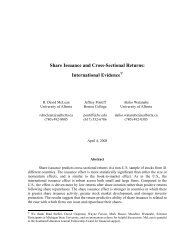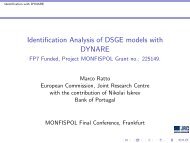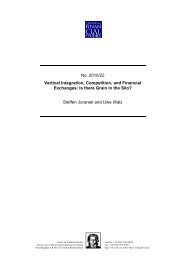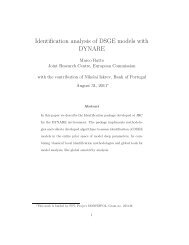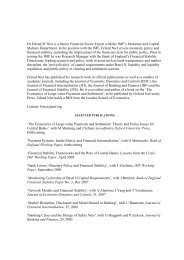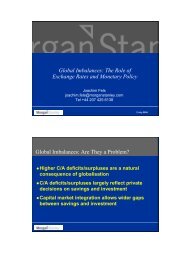Forecasting and Policy Making (Paper) - Center for Financial Studies
Forecasting and Policy Making (Paper) - Center for Financial Studies
Forecasting and Policy Making (Paper) - Center for Financial Studies
Create successful ePaper yourself
Turn your PDF publications into a flip-book with our unique Google optimized e-Paper software.
The nowcasts are updated daily to make sure that the in<strong>for</strong>mation content of the most recent data<br />
realizations is taken into account.<br />
Bańbura et al. (2010) demonstrate the computation <strong>and</strong> interpretation of nowcasts <strong>for</strong> euro area<br />
GDP. They use a dataset of 26 variables. The data is grouped into a part corresponding to real<br />
variables <strong>and</strong> into another part corresponding to nominal variables. The real variable block is further<br />
split into hard data variables, survey variables <strong>and</strong> financial variables. They show how the nowcast<br />
is revised over time as new data becomes available <strong>and</strong> how the different data blocks contribute to<br />
these revisions over time. Their results show that even very sophisticated nowcasting methods may<br />
still deliver fairly imprecise nowcasts or one-quarter backcast of GDP. One of the reasons is that<br />
GDP data is revised substantially even after the first release. <strong>Policy</strong> makers need to take into account<br />
that they have to rely on rather uncertain estimates of the current state of the economy. An overview<br />
<strong>and</strong> illustration of recent nowcasting techniques is given by Giannone <strong>and</strong> Reichlin (2012). Finally,<br />
Giannone et al. (2009) show how to link high frequency nowcasting frameworks with a quarterly<br />
DSGE model in a coherent manner.<br />
<strong>Forecasting</strong> with non-structural time series models<br />
Simple non-structural time series models are used <strong>for</strong> <strong>for</strong>ecasting because they yield <strong>for</strong>ecasts that<br />
are difficult to beat in terms of accuracy. The high accuracy of these <strong>for</strong>ecasts has been recognized<br />
as early as in 1972 in a comparison of <strong>for</strong>ecasts from the large econometric model used by the Fed in<br />
the 1970s (FMP: FRB-MIT-PENN model) <strong>and</strong> simple time series methods: Nelson (1972) compares<br />
the accuracy of one-quarter-ahead <strong>for</strong>ecasts of 14 macroeconomic variables obtained from the FMP<br />
model <strong>and</strong> simple ARIMA models. The simple ARIMA models are more robust <strong>and</strong> yield more<br />
accurate out-of-sample predictions <strong>for</strong> 9 out of the 14 projected variables including GNP growth. 28<br />
The robustness <strong>and</strong> accuracy of simple time series <strong>for</strong>ecasts has been confirmed in many other studies.<br />
Simple time series methods impose no incredible restrictions on the underlying relationships among<br />
variables (Sims, 1980).<br />
A recent comparison of simple non-structural <strong>for</strong>ecasting methods with more sophisticated struc-<br />
tural approaches is the paper by Edge et al. (2010). They compare <strong>for</strong>ecasts from the current version of<br />
the macro-econometric model of the Federal Reserve, the FRB/US model, to <strong>for</strong>ecasts from a DSGE<br />
model, from vector autoregression models (VARs) <strong>and</strong> a simple AR(2) process. Regarding most<br />
variables the <strong>for</strong>ecasts from the AR(2) model are of similar accuracy as the <strong>for</strong>ecasts from the two<br />
structural models. For real GDP growth the DSGE model provides slightly but not significantly better<br />
<strong>for</strong>ecasts, while the FRB/US model per<strong>for</strong>ms somewhat worse. For inflation <strong>and</strong> the federal funds<br />
rate the AR(2) model yields significantly better <strong>for</strong>ecasts than the DSGE model <strong>and</strong> only slightly<br />
less accurate <strong>for</strong>ecasts than the FRB/US model. Edge et al. (2010) find that <strong>for</strong>ecasts from univariate<br />
methods are even more accurate than <strong>for</strong>ecasts from multivariate methods such as VARs <strong>and</strong> Bayesian<br />
28 These results are obtained by using actual realized data <strong>for</strong> future exogenous variables in the FMP model. Without this<br />
perfect <strong>for</strong>esight approach the <strong>for</strong>ecast accuracy of the FMP model would probably decrease further relative to the ARIMA<br />
models.<br />
34



